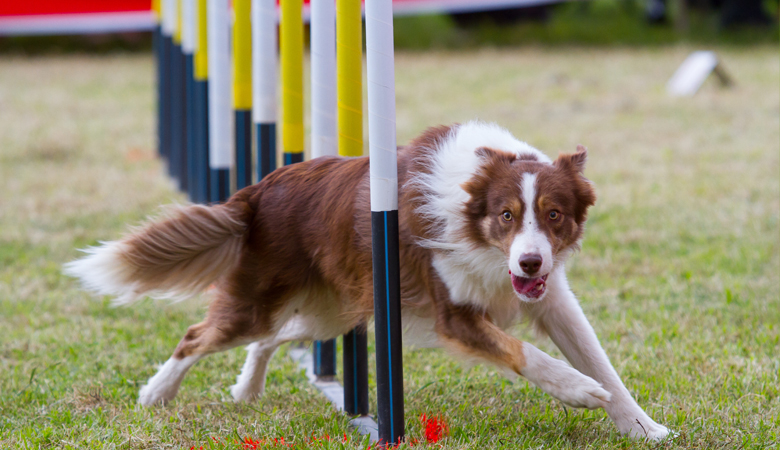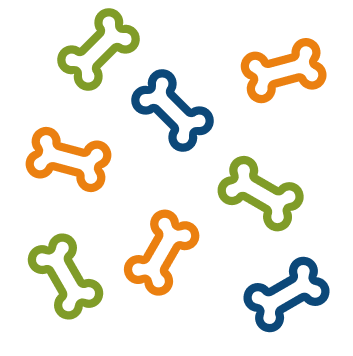Exercising with your dog
Written by Noa |
There are many different sports you can practise with your dog. This article provides a brief overview of the most common dog sports.

Dog sports covered:
- Agility
- Canicross
- Dog Dance
- Dog Frisbee
- English Obedience
- FCI Obedience
- Flyball
- Hunting training
- Rally-O
- Rescue dog work
- Herding work
- Sled dog sports
- Tracking
- Treibball
- Water work
- Working dog IGP
- Greyhound racing
Agility
Agility, also known as “obstacle training”, is a sport where you guide your dog through a course of jumps, tunnels and obstacles as quickly as possible. The height of the jumps depends on the dog’s withers height. It is a sport that involves close cooperation between you and your dog. You motivate your dog to complete the course using voice commands and body language. Recreational agility can be done by any healthy, adult dog (at least 1 year old). However, tunnels may not be suitable for large, heavy dogs, and long-bodied dogs with short legs are less suitable for jumping. Agility is also practised at competition level.
Canicross
Canicross is running together with your dog — and the goal is for your dog to pull you along to help you run faster. The dog wears a well-fitted harness, and you wear a waist belt connected by a bungee leash. Canicross originated as training for sled dog sports. Any healthy, adult dog can take part. Some breeds are naturally faster, but most dogs enjoy running with their owner. Although not yet officially regulated by the national kennel club, races are regularly organised.
Dog Dance
Dog Dance is literally dancing with your dog. You and your dog perform movements that resemble dancing, usually set to music. This sport is perfect for dog owners who enjoy teaching tricks and choreographing routines. There are no mandatory moves, and you can tailor the routine to your dog’s strengths. All breeds can participate as long as the exercises are safe. Dog Dance can be performed competitively, with two disciplines: Freestyle and Heelwork to Music (HTM).
Dog Frisbee
In this sport, the owner throws a frisbee disc for the dog to catch. A specific technique is used to throw the disc properly. While any dog can learn to catch a frisbee, some breeds are more agile than others. Working breeds tend to enjoy it most. Large breeds may find it physically demanding, and brachycephalic (short-nosed) dogs may struggle to hold the disc. If you’re practising with such dogs, it’s advised to join a knowledgeable frisbee club. This sport is also practised competitively.
English Obedience
This sport is all about obedience. The aim is to achieve the highest level of precision in exercises such as heelwork, sorting, and retrieving. It is suitable for all dogs and owners. At the top level, you’ll mostly see herding breeds like Border Collies, known for their intelligence and work drive.
FCI Obedience
Formerly known as Behaviour & Obedience. Like English Obedience, the goal is perfect execution of obedience exercises. This version is regulated in the Netherlands, while English Obedience is regulated in the UK. Both share similarities and are practised in the Netherlands.
Flyball
Flyball is the only team sport in dog sports. Dogs race over hurdles to trigger a ball release from a box, returning with the ball in a relay race format. A team consists of 8 dogs, with a maximum of 2 of the same breed or variety. Dogs must be at least 10 months old, sociable, and physically able to catch, run, and jump. Speed, agility, and obedience are essential. Flyball is practised both recreationally and competitively.
Hunting training
To take your dog hunting, proper training is essential. The goal is to locate, point to, follow, drive or retrieve game. Hunting breeds especially enjoy this work, but any dog can take pleasure in tracking and retrieving. You can train recreationally or for competition. Participation in competitions requires passing an exam. The annual highlight is the Nimrod trial in November, by invitation only.
Rally-O
The “O” stands for obedience. This sport combines obedience and agility. You and your dog follow a course with various obedience exercises marked by signs. Each course is unique and adapted to your level. It is suitable for all dogs, provided they are at least 6 months old and have solid obedience training. Rally-O can be done recreationally or in competition.
Rescue dog work
Rescue work is fun but also very practical. Dogs have an excellent sense of smell, and with some drive and hunting instinct, they can become very skilled at locating missing persons. Suitable dogs should be agile, physically capable and resistant to extreme conditions. This can be a sport or a real-world task. In practice, rescue work may take you abroad in challenging environments (earthquakes, floods, disaster zones). The dog must be well-socialised, obedient, and hold the “Traffic-Safe Dog” diploma.
Herding work
Herding involves keeping and moving livestock. There’s guarding (holding stock in place) and driving (moving it). Sheep herding focuses on driving. Border Collies are especially suited, but other herding breeds can qualify too. A Herding Instinct Test helps assess aptitude. This sport can be practised recreationally or competitively. For competitions, dogs must pass the Herding Working Test.
Sled dog sports
One or more dogs run pulling a sled steered by a musher. When there’s no snow, a wheeled cart, bike, scooter or skis can be used. This sport is intended for breeds historically bred for pulling: Alaskan Malamute, Greenland Dog, Samoyed, Siberian Husky, and Eskimo Dog. In the Netherlands, only these breeds with a certified pedigree may take part.
Tracking
Any dog can learn to track. If you want to pursue tracking as a sport or work, motivation is key. There are three main forms:
- Tracking for working dogs
- Tracking for hunting dogs (blood tracking)
- Clean Boot (locating missing persons)
These can all be done recreationally or competitively.
Treibball
Treibball involves the dog pushing up to 8 large, brightly coloured, lightweight balls into a goal within 10 minutes, using your commands. It’s a true teamwork sport. It is low-impact and suitable for young, elderly or physically challenged dogs. Treibball can be done for fun or in competition.
Water work
Some breeds were historically used by fishermen to retrieve nets or save people from drowning. Many still have this natural ability. Water work as a sport aims to earn certificates in group settings. Exercises mimic real-life situations, such as retrieving a person, rope or paddle. It also includes obedience training. Water work suits Newfoundlands, Landseers and Leonbergers best, but retrievers, poodles and herding dogs may also qualify — if healthy, obedient, and cooperative.
Working dog IGP
IGP stands for Internationale Gebrauchshunde Prüfungsordnung, a programme for working breeds recognised by the FCI. It includes protection work, tracking, and obedience. In protection, the dog locates, barks at and controls a decoy (helper). If the helper tries to flee, the dog intervenes. Dogs are trained to target the sleeve. This sport is for true working breeds and is practised recreationally or competitively. Dogs must hold a “Traffic-Safe Dog” certificate.
Greyhound racing
Greyhound sports include track racing (grass or sand) and coursing (chasing a lure across open fields). These dogs need lots of movement but can’t be let off-leash safely because of their prey drive. Racing offers them a safe outlet. Only greyhounds and certain sighthound crosses (e.g., Pharaoh Hound, Podenco, Cirneco) may compete nationally or internationally. Basenjis and Portuguese Podengos may enter national races. The sport is mainly competitive.



